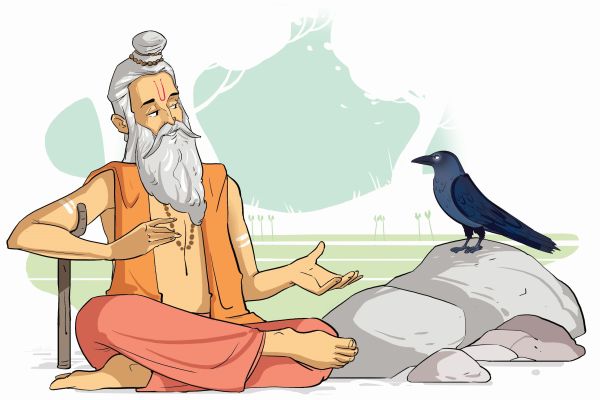About spheres and discs
- POSTED ON: 23 Apr, 2024
- TOTAL VIEWS: 401 Views
- POSTED BY: R. Krithika | Text: Jagadeesh Kanna
- ARTICLE POINTS: 100 Points
In the last episode, Kakabhushundi allowed himself to be caught by Rama, who mischievously put the crow into his mouth. Before Kausalya pulled him out, Kakabhushundi got a glimpse of various layers of the Earth, which Sage Lomasa explained to him as that below and above the surface. He also indicates that there were more mysteries forthcoming for Kakabhushundi to learn.

Sage Lomasa: Have you ever thought about the Solar System and why every planet is spherical and why most celestial objects spin? Let’s hear some answers from you before I tell you about it.
Kakabhushundi: Okay. I’ll try. Since most objects – whether planets, stars or galaxies – seem to be spherical spinning, may be is has something to do with the heavier part moving at the top and bottom like how we make dough balls. Bigger galaxies seem to be flat, like a chapathi.
Sage Lomasa: Any other ideas?
Kakabhushundi: What about spherical pebbles that are smoothened and shaped by the continuous movement of water around it? Does something similar happen in outer space as well?
Sage Lomasa: Both your answers are logical. Scientists like Einstein proposed the idea of dark matter as a particle, as it expands faster than the speed of light. Nobody has been able to prove it but most calculations that human science will make in their modern times will be based on considerations of dark matter as vacuum.
Kakabhushundi: I wonder why everything in the universe spins: atoms, molecules, planets, stars, solar systems, galaxies … where do they all go? Into some huge black hole?
Sage Lomasa: That is what we are trying to figure out. Have you heard of gravity?
Kakabhushundi: Yes of course. Newton’s questioning of why everything is pulled towards each other will lead to the Theory of Gravity. And Einstein later will come up with the concept of mass creating a dip in the fabric of space time.

Sage Lomasa: Exactly. Take any mass – planets, stars, or even a molecule – has its own gravity to pull and hold things in a spherical shape. Most of its gravity or pulling force is in the centre?
Kakabhushundi: Like our Sun with more mass in the centre holding the planets by its gravitational pull.
Sage Lomasa: Partly yess but that’s not the full answer. There are other reasons such as the God particle, the Theory of Special Relativity…
Kakabhushundi: Can you please keep it simple? Basically, gravity pulls things towards the centre and the sphere is the most ideal and efficient shape for this.
Sage Lomasa: Well yes. Technically the sphere is the most efficient 3D shape with large volume.
Kakabhushundi: Is that why water, when it floats in space, is spherical? But nothing seems to be a perfect sphere.
Sage Lomasa: Because gravity fluctuates, expands, contracts with highs and lows … therefore, the masses are imperfect spheres.
Kakabhushundi: Then what about the flattened discs?

Sage Lomasa: That is due to something called centripetal force, which tries to overcome the gravitational pull but ends up sticking together in a disc shape. You can escape gravitational influence with the help of high spin and angular momentum, but the rapid spinning can cause the flat disc shape. Like black holes and galaxies.
Kakabhushundi: Wait, let me see if I got it right. The spherical shape is due to gravity and the flat disc shape is due to high spin. But how do they spin?
Sage Lomasa: We don’t have a clear explanation for that. All we know is that spin is a fundamental quality of a particle in quantum mechanics like gravitational pull and angular momentum. Experiments with the human body spinning in a chair show that the spin in faster closer to the centre and slower when farther out. However, there are some rare particles like Helium 4 nucleus that does not spin. For now, it looks like everything spins but there is not substantial proof.
Kakabhushundi (groans): This is all so confusing. Can we stop here and do something else?
Sage Lomasa: All right. I’ll show you how to make a scaled-down model of the Solar System.
The author is the founder and CEO of Vaayusastra Aerospace, an IIT-Madras incubated ed-tech startup that offers Air Science workshops for children between five and 14 years.